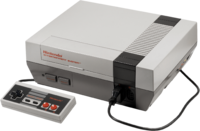| Site Notice |
|---|
|
We have a limited coverage policy. Please check our coverage page to see which articles are allowed. |
Nintendo Entertainment System
The Nintendo Entertainment System (ファミコン, Famikon, Famicom), commonly abbreviated as NES or Nintendo, was the first home gaming console manufactured by Nintendo. It was the system that saved the industry after the Great fall of video games of 1983.
The NES debuted in Japan as the Famicom (Family Computer) in 1983. After selling over 2.5 million units by the end of 1984, Nintendo decided it would bring its console to North America. They first tried negotiating with Atari to have them release it, but the deal fell through, so Nintendo decided that they would release the console themselves.
The Famicom was difficult to pitch to retailers due to the current video game market being oversaturated with poor titles and low consumer interest. After tweaking the system a few times, Nintendo finally pitched the console as the Nintendo Entertainment System and emphasized its toy-like features such as the Robot Operating Buddy (R.O.B.) and the Zapper light gun. Retailers finally began to take interest and the system debuted in test markets in New York City and Los Angeles before eventually being released all across the United States.
The NES grew to wide success, outselling all of its competitors and leading the worldwide video game market. Many NES games are considered classics today, such as Super Mario Bros., Duck Hunt, and 'The Legend of Zelda'.
In America, the NES was sold in 3 packages:
- Control Deck: Contained the console, two controllers and the needed connections.
- Action Set: This set included the console, two controllers, the Super Mario Bros./Duck Hunt cartridge, the Zapper, and the connections.
- Power Set: The most complete package, it contained the console, two controllers, a Super Mario Bros./Duck Hunt/World Class Track Meet cartridge, the Zapper, the Power Pad and the connections.
Gradually, the competition began to catch up and the next generation of home consoles, such as the SEGA Genesis and Nintendo's own Super Nintendo Entertainment System, began to overtake the NES's market share. Finally, after a full decade of production, the NES was formally discontinued in the U.S. in 1995. By this time, over 60 million units and over 500 million games had been sold throughout the world.
Famicom Disk System
In Japan, an accessory for the Famicom was released named the Famicom Disk System. The Disk System connected to the Famicom via a cartidge slot adapter and used rewritable double-sided floppy disks ("Disk Cards") to store game data. These Disk Cards were the first Famicom games to allow a player to save their game progress. This allowed for sales of cheaper games as manufacturing a disk was much less expensive than a cartridge. Many of these titles would later be re-released as regular Famicom cartridges, using password saving and battery-backed memory in lieu of the disks' rewritable memory. While there were plans to release the Disk System in North America, this never happened and all Disk System games released in North America were released as regular cartridges.
|
|
| |||||||||||||||||||||
| |||||||||||||||||||||
| |||||||||||||||||||||



